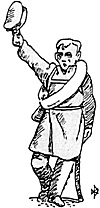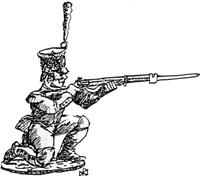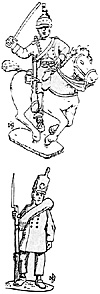
Sieges
All major towns are walled and have a garrison of 30 figures, capitals 50. A defended walled town may be captured by:- Treachery
Starvation
Surprise
Assault
Regular siege operations
Treachery
Each week during siege phase roll 2D6: 12 equals treachery hands city over. A 2 means town on half rations
Starvation
When any town is besieged, roll a 2d6. The result X 100 = amounts of supplies within town. Each figure within the town uses one supply point per week. The garrison can be put on half rations. If rations run out, each week roll a 2d6. 8+ means the garrison surrenders.
Surprise
At initial investiture, roll a 2d6: A result of 2 or 12 means the town is taken by surprise and captured.
Assault
 Each city has d5 defence strength
Each city has d5 defence strength
Strength x garrison = total defence strength. To attempt an assault, the attacker must have at least a 3:2 advantage. Use Tony Bath's odds rules. If result is bloody siege, then the attacker must break up siege and may not return unless reinforced with at least half their number.
Regular Siege
Every siege phase after first week follow this sequence.
- 1. Possible treachery
2. Disease check
3. Defenders losses
4. Attackers losses
5. Damage to wall
6. Possible assault
7. Starvation
8. Morale Disease throw 2d6 for each side: 12+ for attackers, 11+ for defenders and a disease starts. If one has disease then +1 for other. Disease will cause d6 deaths per turn. Also, +1 if on half rations
Defenders' loss = d6
Attackers' loss = d4
Damage to wall: 2d6
- 10+ one wall defence factor off.
+1 if 4:1 odds
+1 per battery
+ 4 siege train
Each time a factor is lost roll 2d6: 9+ means defender surrenders.
Siege Train
A siege train is the collection of heavy guns that can only be used against a besieged city. Each major country possesses one and one only.
Mobilisation
 A short note on mobilisation is required here. Each unit has a parent town at which location it mobilises. These towns are spread over the map and so mobilisation and consolidated will take some time, this is how I intended it to be I didn't want armies to suddenly appear from nowhere. The impact on the following campaign was very important.
A short note on mobilisation is required here. Each unit has a parent town at which location it mobilises. These towns are spread over the map and so mobilisation and consolidated will take some time, this is how I intended it to be I didn't want armies to suddenly appear from nowhere. The impact on the following campaign was very important.
Forces:
- France and allies 15,576 inf, 3,168 cav, 48 can = 18,744 men
Prussia 7,929 inf, 1,056 cav, 24 can = 8,976 men
Russia 5,280 inf, 1,584 cav, 24 can = 6,864 men
Britain 4,620 inf, 1,056 cav, 12 can = 6,204 men
Austria 3,960 inf, 528 cav, 8 can = 4,488 men
It can be seen that the Allies outnumber France. The geography is that Prussia is adjacent to France, Russia is adjacent to France's allies but with a large country and a slow mobilisation, Britain and Austria come on at the very far edge of the map, and also have a great distance to move.
The early weeks were all on politics as countries decided on their stance, of course the rules were written so that war would be declared eventually. By the end of January Prussia was close to mobilising, and France was keeping a wary watch on her. This unlikely peace held out until the 1st March when Prussia decided to mobilise although not declaring war just yet. This move was kept secret from any French spies. Prussia finally declared war on 22nd March and France was allowed to begin mobilisation, unfortunately for Prussia none of her allies were in a position to help her.
At this critical time Prussia had three options, she could either wait for her allies, attack the French allies, or attack France itself. Against all reason Prussia decided on an immediate attack on mainland France. The reasoning being that she was almost fully mobilised and France was but beginning and would take many weeks to be organised. The die was cast. Please note that all decisions are made by dice throws the odds being decided on by me, so for example in the case above, 1-4 would have made Prussia wait for her Allies, 5 an attack on Poland and Saxony, and a 6 an attack on France.
Yes, a 6 was thrown. The Prussian plan of action was decided to advance and disrupt the French mobilisation, take and hold the City of Westminster and attack any French army in the area. To this end the main army was to march directly down the road to Westminster whilst a detachment of 3,000 men would move down a parallel road 30 miles to the east and then join the main army. The French orders were simplicity themselves. The army was to converge at either New Windsor or Westminster, and then the Prussian army was to be attacked immediately.
After some delay both Prussian columns advanced over the border on 31st March in bright sunlight. By this time the French army was beginning to mobilise itself at different rates. The Prussian outposts reached Westminster by 3rd April, on the same day the secondary column displaced the Marines and chased off some French Artillery. On Sunday the 5th April Westminster was besieged by the Prussians, on the same day Russian began mobilisation some many miles away. The Prussian commander, Moller, decided that he didn't have enough strength to assault Westminster, so the siege continued.
Unfortunately for the Prussians, the French had now arrived in enough strength to cause major problems. The various units were attempting to outflank the Prussians, would Moller be caught in a trap? Luckily a French dispatch was captured in time to allow the chance of escape, i.e. a 6 was thrown, Moller ordered a retreat to Littlestown.
The French allowed Moller and his army to retreat whilst they organised themselves into an army. The Poles and Saxons are ordered to defend their own countries in case of Russian attacks. The long Prussian retreat continued, but good news arrived with the information that Britain was mobilising. This mobilisation had started on 12th April unfortunately England was a long way from Prussia.
By the 14th the Prussian army had picked a strong position at Myersville guarding the river crossing. The whole Prussian army is there as the detachment had joined back up. The French were very slow at gathering their army together at Westminster.
A Small Solo Napoleonic Campaign Part 1
Back to Table of Contents -- Lone Warrior #129
Back to Lone Warrior List of Issues
Back to MagWeb Magazine List
© Copyright 2000 by Solo Wargamers Association.
This article appears in MagWeb (Magazine Web) on the Internet World Wide Web.
Other military history articles and gaming articles are available at http://www.magweb.com
